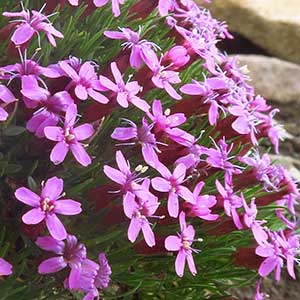Silene acaulis
Silene grayi
moss campion, silène acaule
Gray's campion, Gray's catchfly, Maui catchfly
erect from sometimes decumbent base, little-branched, subscapose with 2–3 pairs of reduced leaves, 10–20(–30) cm, finely retrorse-puberulent proximally, stipitate-glandular and viscid in inflorescence.
erect, leafy proximally, 3–6(–15) cm, old leaves persistent at base.
mostly basal, densely crowded and imbricate, sessile;
blade 1(–3)-veined, linear-subulate to lanceolate, 0.4–1(–1.5) cm × 0.8–1.5(–2) mm, margins cartilaginous, often ciliolate especially proximally, apex acute, glabrous to scabrous.
basal petiolate, blade oblanceolate to spatulate, (1.5–)2–5(–6) cm × 2–7 mm, thick and ± fleshy, apex broadly acute, puberulent on both surfaces;
cauline blades linear-oblanceolate to linear-lanceolate, 0.5–2 cm × 1–3 mm.
solitary flowers.
open, 1–3(–5)-flowered, bracteate;
bracts lanceolate, 2–7 mm, herbaceous.
2–40 mm.
erect and straight or slightly deflexed near apex, 5–20 mm, stipitate-glandular, hairs with colorless septa.
bisexual or unisexual, all plants having both staminate and pistillate flowers, others having only pistillate flowers, subsessile or borne singly on peduncle;
calyx 10-veined, lateral veins absent, tubular to campanulate, (5–)7–10 mm, herbaceous, margins often purple tinged, dentate, sometimes ciliate, ± scarious, glabrous, lobes lanceolate to ovate, 1–2 mm;
petals bright pink, rarely white, limb unlobed to shallowly 2-fid, 2.5–3.5 mm, base tapered into claw, auricles and appendages poorly developed;
stamens exserted in staminate flowers, not so or aborted in pistillate flowers;
styles 3.
calyx prominently 10-veined, in flower broadly cylindric, 8–10 × 3–4 mm, in fruit becoming campanulate and somewhat contracted at base, 8–12 × 5–7 mm, membranous between veins, margins dentate, hairs with colorless septa, veins parallel, purplish, with pale commissures;
lobes ovate, ca. 2 mm, shorter than tube, apex flushed with dark red, shortly apiculate with broad, scarious margins, glandular, puberulent;
petals exserted, pink to dusky purple, clawed, claw equaling or slightly longer than calyx, limb 2-lobed, 3–5 mm, each lobe with lateral tooth, tooth usually small, rarely larger and equaling lobes, appendages 2, 0.7–1.5 mm;
stamens equaling petals;
stigmas 3(–4), equaling petals.
3-locular, cylindric, equaling or to 2 times calyx, opening by 6 recurved teeth;
carpophore ca. 1 mm.
slightly exceeding calyx, ovoid, opening with 6 (or 8) ascending to slightly recurved teeth;
carpophore 2–3 mm.
light brown, reniform, 0.8–1(–1.2) mm broad, dull, shallowly rugose.
pale brown, reniform, 2–3 mm, sides with close radiating ridges, margins broadened and winglike.
= 24.
= 48.
Silene acaulis
Silene grayi
Silene acaulis is a variable species, and most workers have recognized infraspecific taxa in North America: subsp. acaulis (subsp. exscapa and subsp. arctica), which is predominantly arctic; and subsp. subacaulescens, which extends down the Rocky Mountains from Alaska to Arizona and New Mexico. In subsp. acaulis, the leaves are flat and short and the flowers are subsessile and smaller in size. Subspecies subacaulescens is typically a larger, less-compact plant with longer, narrower leaves and larger, pedunculate flowers. However, in many populations, these two variants are poorly differentiated, and in others both occur together, connected by intermediates.
Silene acaulis is widely distributed in arctic and alpine Europe.
(Discussion copyrighted by Flora of North America; reprinted with permission.)
Silene grayi is a small montane relative of S. parryi, but it differs in having small, fleshy leaves (ca. 2–4 cm), most of which are in basal tufts. The seeds are also larger and have a thickened wing. Some plants in the mountains of Washington and Oregon appear to intergrade and need further study.
A hybrid between Silene grayi and S. campanulata has been collected in the Siskiyou Mountains of northern California, an area where both species occur.
(Discussion copyrighted by Flora of North America; reprinted with permission.)


